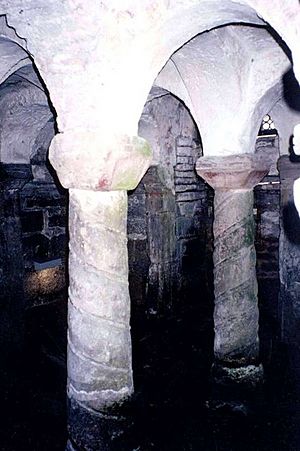Wigstan facts for kids
Quick facts for kids SaintWigstan (Wystan, Wistan) |
|
|---|---|
| Martyr | |
| Died | c. 839/840 |
| Honored in | Roman Catholic Church Anglican Communion Eastern Orthodox Church |
| Major shrine | Evesham Abbey (destroyed) |
| Feast | 1 June |
Wigstan (died around 840 AD), also known as Saint Wystan, was a young prince from the ancient kingdom of Mercia. He was the son of Prince Wigmund and Princess Ælfflæd. His mother, Ælfflæd, was the daughter of King Ceolwulf I of Mercia. Wigstan is remembered as a saint because of his strong religious beliefs and the way he died.
Contents
Wigstan's Story
Not much is known about Wigstan's early life. He came from a royal family in Mercia, a powerful Anglo-Saxon kingdom. His father, Wigmund, was the son of King Wiglaf. His mother, Ælfflæd, was the daughter of King Ceolwulf I. This made Wigstan a grandson of two Mercian kings.
Choosing a Religious Life
Wigstan's father, Wigmund, passed away before his own father, King Wiglaf. This meant that Wigstan was next in line to become king of Mercia. However, when King Wiglaf died in 839, Wigstan chose a different path. He decided he did not want to be king. Instead, he wanted to live a religious life, perhaps in a monastery.
Because Wigstan chose not to rule, his great-uncle, Beorhtwulf, became the new king of Mercia.
A Family Conflict
King Beorhtwulf had a son named Beorhtfrith. Beorhtfrith wanted to marry Wigstan's mother, Ælfflæd, who was now a widow. However, Wigstan said no to this marriage. He believed they were too closely related for it to be allowed by the church.
Beorhtfrith was very angry about Wigstan's decision. He pretended to visit Wigstan in peace. But when they met, Beorhtfrith attacked Wigstan. He hit Wigstan with his dagger, and one of his servants then killed Wigstan with a sword.
The Death of Saint Wigstan
Historians like Florence of Worcester wrote about Wigstan's death. They said he was killed on June 1st, around the year 840. He was called a "martyr" because he died for his beliefs.
Beorhtfrith, son of Beorhtwulf, king of Mercia, wrongly killed his cousin, St Wigstan on June 1st. This was the day before Pentecost. Wigstan was the grandson of two Mercian kings. His father, Wigmund, was the son of King Wiglaf. His mother, Ælfflæd, was the daughter of King Ceolwulf. Wigstan's body was taken to a famous monastery called Repton. He was buried in the tomb of his grandfather, King Wiglaf. Miracles from heaven showed that he was a true martyr. A bright column of light appeared where the innocent saint was killed. It stayed visible for 30 days.
Wigstan's Legacy
After his death, Wigstan became a very famous saint. Many people believed he was a holy person. The place where he was first buried, Repton, became a popular spot for pilgrimage. Pilgrimage is a journey to a holy place.
Later, a king named Cnut the Great moved Wigstan's remains, called "relics," to Evesham Abbey. A monk named Dominic of Evesham wrote a book about Wigstan's life there. This book helped spread stories about Saint Wigstan.
Stories About Saint Wigstan
The remains of Saint Wigstan were moved to the Abbey at Evesham. A book about his life, called a vita, was written there. This book told stories about his holy actions. It was written by Dominic of Evesham, a leader at the abbey in the early 1100s.
Sadly, much of Evesham Abbey, including the tomb where Wigstan was buried, was destroyed many years later. This happened during a time called the Dissolution of the Monasteries.
In more recent times, an artist named Margaret E.A. Rope created special windows for a church in Wistanstow. These windows show the story of the miraculous light that appeared where Wigstan died. This light helped people find his body.
More to Explore
- You can still see the Anglo-Saxon crypt tomb at Repton, Derbyshire, where Wigstan was first buried.
- The famous British poet W. H. Auden was named in honor of Saint Wystan. His family had connections to Repton School and Wistanstow church.


